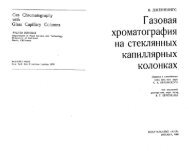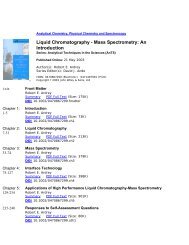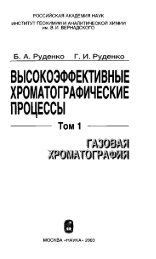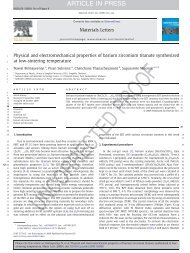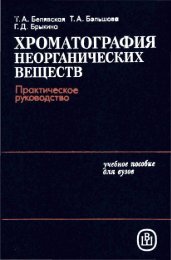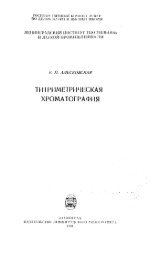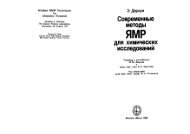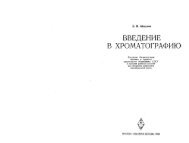- Page 1 and 2: Hellmut Jork, Werner Funk, Walter F
- Page 3 and 4: VI Foreword in many cases, an elega
- Page 5 and 6: Contents Parti Methods of Detection
- Page 7 and 8: A1V L,omenis Hydrochloric Acid Vapo
- Page 9 and 10: 1 Introduction The separation metho
- Page 11 and 12: Number 600 too 200 1 Introduction 1
- Page 13: Colorless substances absorb at wave
- Page 17 and 18: io z rnysicai Meinous oj ueieciwn F
- Page 19 and 20: 22 2 Physical Methods of Detection
- Page 21 and 22: 26 2 Physical Methods of Detection
- Page 23 and 24: 3U z rnysicai meinous oj veiecuun P
- Page 25 and 26: 34 2 Physical Methods of Detection
- Page 27 and 28: 38 2 Physical Methods of Detection
- Page 29 and 30: 42 2 Physical Methods of Detection
- Page 31 and 32: 46 2 Physical Methods of Detection
- Page 33 and 34: 50 2 Physical Methods of Detection
- Page 35 and 36: 3 Chemical Methods of Detection Eve
- Page 37 and 38: Chemical Meinoas oj ueiecuun Fig. 3
- Page 39 and 40: 62 3 Chemical Methods of Detection
- Page 41 and 42: 66 3 Chemical Methods of Detection
- Page 43 and 44: 70 3 Chemical Methods of Detection
- Page 45 and 46: 74 3 Chemical Methods of Detection
- Page 47 and 48: uj • improving the detection sens
- Page 49 and 50: 82 3 Chemical Methods oj Detection
- Page 51 and 52: 86 3 Chemical Methods of Detection
- Page 53 and 54: 90 3 Chemical Methods of Detection
- Page 55 and 56: 94 3 Chemical Methods of Detection
- Page 57 and 58: 98 3 Chemical Methods of Detection
- Page 59 and 60: 30-- 20 4- 10 •• P-7 P-8 —I 1
- Page 61 and 62: 106 3 Chemical Methods of Detection
- Page 63 and 64: 110 3 Chemical Methods of Detection
- Page 65 and 66:
lit J ^ncniiLui lvicinuus uj [129]
- Page 67 and 68:
118 3 Chemical Methods of Detection
- Page 69 and 70:
122 4 Documentation and Hints for C
- Page 71 and 72:
T LsvLumcniuuuri unu liiruijur \^nr
- Page 73 and 74:
130 4 Documentation and Hints for C
- Page 75 and 76:
zone size and distribution of subst
- Page 77 and 78:
138 4 Documentation and Hints for C
- Page 79 and 80:
Reagent for: Cations [1-7] Preparat
- Page 81 and 82:
146 Alizarin Reagent Detection and
- Page 83 and 84:
150 Aluminium Chloride Reagent UV l
- Page 85 and 86:
4-Aminobenzoic Acid Reagent Reagent
- Page 87 and 88:
158 2-Aminodiphenyl — Sulfuric Ac
- Page 89 and 90:
162 4-Aminohippuric Acid Reagent 1
- Page 91 and 92:
Reagent for: Ammonia Vapor Reagent
- Page 93 and 94:
Ammonium Thiocyanate — Iron(III)
- Page 95 and 96:
174 Amy lose — Potassium lodate/I
- Page 97 and 98:
1/0 Anuine — Aiaose neageni Mobil
- Page 99 and 100:
15 L Anmne — uipnenyiamine — rn
- Page 101 and 102:
186 Aniline — Phosphoric Acid Rea
- Page 103 and 104:
i s\j Jiituuuz — -I ninuiH. S1LIU
- Page 105 and 106:
li»4 X-Anilinonaphthalene-1-sulfon
- Page 107 and 108:
198 Anisaldehyde — Sulfuric Acid
- Page 109 and 110:
Reagent for: • Ketoses [1] • Gl
- Page 111 and 112:
Antimony(III) Chloride Reagent (Car
- Page 113 and 114:
Antimony(V) Chloride Reagent Reagen
- Page 115 and 116:
214 Berberine Reagent Under UV ligh
- Page 117 and 118:
218 2,2'-Bipyridine - Iron(III) Chl
- Page 119 and 120:
222 Blue Tetrazolium Reagent Note:
- Page 121 and 122:
224 Bratton-Marshall Reagent Substa
- Page 123 and 124:
Bromocresol Green — Bromophenol B
- Page 125 and 126:
232 Bromocresol Purple Reagent Meth
- Page 127 and 128:
236 tert-Butyl Hypochlorite Reagent
- Page 129 and 130:
240 7-Chloro-4-nitrobenzo-2-oxa-l,3
- Page 131 and 132:
244 Copper (II) acetate — Phospho
- Page 133 and 134:
Copper(II) Sulfate Reagent Reagent
- Page 135 and 136:
2,6-Dibromoquinone-4-chloroimide Re
- Page 137 and 138:
2,6-Dichlorophenolindophenol Reagen
- Page 139 and 140:
296-Dichloroquinone-4-chloroimide R
- Page 141 and 142:
204 Zp-Uichloroqumone-4-cMorovniOe
- Page 143 and 144:
268 2,5-Dimethoxytetrahydrofuran
- Page 145 and 146:
Lii. t-uimeinyiummocmnumaiaenyae
- Page 147 and 148:
276 ^,4-Uimtrophenylhydrazine Reage
- Page 149 and 150:
280 Diphenylboric acid-2-aminoethyl
- Page 151 and 152:
Diphenylboric Anhydride — Salicyl
- Page 153 and 154:
Reagent for: Fast Blue Salt B Reage
- Page 155 and 156:
tasi mue salt a Keagent 1 5 10 15 2
- Page 157 and 158:
ZVb tluorescamine Keagent Sulfonami
- Page 159 and 160:
300 Formaldehyde - Sulfuric Acid Re
- Page 161 and 162:
304 Hydrochloric Acid Vapor Reagent
- Page 163 and 164:
308 Hydrogen Peroxide Reagent radia
- Page 165 and 166:
312 8-Hydroxyquinoline Reagent Proc
- Page 167 and 168:
310 iron(iii) L^moriae — fercnion
- Page 169 and 170:
5Z\) isonicotinic Acid Hydrazide Re
- Page 171 and 172:
JZt Ljeaa{ii) Aceiaie Basic neagem
- Page 173 and 174:
In situ quantitation: The fluorimet
- Page 175 and 176:
332 Lead(IV) Acetate — Fuchsin Re
- Page 177 and 178:
JJO manganeseinj ^nionae — zuijun
- Page 179 and 180:
Mercury(II) Salt - Diphenylcarbazon
- Page 181 and 182:
2-Methoxy-2,4-diphenyl-3(2H) furano
- Page 183 and 184:
jis 3-Meinyi-z-Denzotniazoiinone-ti
- Page 185 and 186:
jji i,*-ivupninoquinone-4-sulJonic
- Page 187 and 188:
JDO mnnyarui — ^.oiuatne iteagent
- Page 189 and 190:
360 4-(4-Nitrobenzyl)pyridine Reage
- Page 191 and 192:
Reagent for: • Steroids [1-8] •
- Page 193 and 194:
Peroxide Reagent (1-Naphthol - N 4
- Page 195 and 196:
1,2-Phenylenediamine — Trichloroa
- Page 197 and 198:
Phosphomolybdic Acid Reagent Reagen
- Page 199 and 200:
Reagent for: o-Phthalaldehyde Reage
- Page 201 and 202:
384 o-fhthaiaiaenyae neageni [16] G
- Page 203 and 204:
Pinacryptol Yellow Reagent Reagent
- Page 205 and 206:
Potassium Hexacyanoferrate(III) —
- Page 207 and 208:
396 Potassium Hexacyanoferrate(III)
- Page 209 and 210:
4UU fyrocatechol Violet Reagent 1 2
- Page 211 and 212:
Reagent for: Rhodamine 6G Reagent
- Page 213 and 214:
Silver Nitrate — Sodium Hydroxide
- Page 215 and 216:
Preparation of Reagent Dipping solu
- Page 217 and 218:
Tetracyanoethylene Reagent (TCNE Re
- Page 219 and 220:
Trichloroacetic Acid Reagent Reagen
- Page 221 and 222:
tz.t i rinuruoenzenesuijonw ACIU ne
- Page 223 and 224:
4/5 vanadium{ v) — auijunc Acid R
- Page 225 and 226:
432 Vanillin — Phosphoric Acid Re
- Page 227 and 228:
t JO vamuin — roiassium tiyaroxid
- Page 229 and 230:
Layer Mobile phase Migration distan
- Page 231 and 232:
Index ABP = 2-amino-5-bromophenyl(p
- Page 233 and 234:
Benztriazole -, derivatives 281 ff
- Page 235 and 236:
Disaccharides 154,161,163,179,181,
- Page 237 and 238:
430 maex Isoniazide 318 Isonicotini
- Page 239 and 240:
40U maex -, side on 27 -, window ma
- Page 241 and 242:
464 Index Triphenodioxazines 411 Tr
- Page 243 and 244:
Prof. Dr. H. Jork UniversitSt des S
- Page 245 and 246:
VIII Preface to Volume lb Particula
- Page 247 and 248:
Contents Foreword Preface to Volume
- Page 249 and 250:
XVI Contents Potassium Dichromate -
- Page 251 and 252:
4 Introduction For the same reason
- Page 253 and 254:
8 Introduction [36] Wilson, I. D.,
- Page 255 and 256:
12 / Activation Reactions The inorg
- Page 257 and 258:
16 1 Activation Reactions The excit
- Page 259 and 260:
20 1 Activation Reactions These few
- Page 261 and 262:
24 1 Activation Reactions Migration
- Page 263 and 264:
28 / Activation Reactions of malona
- Page 265 and 266:
32 / Activation Reactions Table 2.2
- Page 267 and 268:
36 / Activation Reactions In situ q
- Page 269 and 270:
40 / Activation Reactions [4] Egg,
- Page 271 and 272:
2 Reagents for the Recognition of F
- Page 273 and 274:
48 Table 4: (continued) Functional
- Page 275 and 276:
52 2 Reagents for the Recognition o
- Page 277 and 278:
3 Reagent Sequences Thin-layer chro
- Page 279 and 280:
60 5 Reagent Sequences A B Fig. 23:
- Page 281 and 282:
t>4 5 Reagent Sequences Here the al
- Page 283 and 284:
68 3 Reagent Sequences tert-Butyl H
- Page 285 and 286:
72 3 Reagent Sequences tert-Bnty\ H
- Page 287 and 288:
76 3 Reagent Sequences Cerium(IV) S
- Page 289 and 290:
80 3 Reagent Sequences Sodium Hydro
- Page 291 and 292:
84 3 Reagent Sequences Sodium Hydro
- Page 293 and 294:
OO J xvcugcric uc Tin(II) Chloride-
- Page 295 and 296:
92 3 Reagent Sequences Tkanium(III)
- Page 297 and 298:
96 3 Reagent Sequences Reagent 4 Co
- Page 299 and 300:
100 3 Reagent Sequences Nitric Acid
- Page 301 and 302:
104 3 Reagent Sequences Reagent 2 R
- Page 303 and 304:
108 3 Reagent Sequences Tin(Il) Chl
- Page 305 and 306:
112 3 Reagent Sequences 1 2 3 4 M 5
- Page 307 and 308:
116 3 Reagent Sequences air. It was
- Page 309 and 310:
120 3 Reagent Sequences Hydroxylami
- Page 311 and 312:
124 3 Reagent Sequences Borate Buff
- Page 313 and 314:
128 3 Reagent Sequences Diphenylami
- Page 315 and 316:
132 3 Reagent Sequences Tible 1: Co
- Page 317 and 318:
136 3 Reagent Sequences Reaction Th
- Page 319 and 320:
140 3 Reagent Sequences [36] Bomtra
- Page 321 and 322:
144 Acridine Orange Reagent Reactio
- Page 323 and 324:
148 Ammonium Monovanadate-p-Anisidi
- Page 325 and 326:
152 Ammonium Thiocyanate Reagent Me
- Page 327 and 328:
156 4,4'-Bis(dimethylamino)thiobenz
- Page 329 and 330:
160 N-Bromosuccinimide Reagent Proc
- Page 331 and 332:
164 N-Bromosuccinimide-Robinetin Re
- Page 333 and 334:
168 Cacotheline Reagent Method The
- Page 335 and 336:
172 Chloramine T Reagents Table 1:
- Page 337 and 338:
176 Chloramine T-Mineral Acid Reage
- Page 339 and 340:
180 Chloramine T-Sodium Hydroxide R
- Page 341 and 342:
184 Chloramine T- Trichloroacetic A
- Page 343 and 344:
Reagent for: /7-Chloranil Reagent
- Page 345 and 346:
192 p-Chloranil Reagent Procedure T
- Page 347 and 348:
196 Chlorine-Potassium Iodide-Starc
- Page 349 and 350:
200 Chlorine-4,4'-Tetramethyldiamin
- Page 351 and 352:
Reagent for: Chlorine - o-Tolidine
- Page 353 and 354:
208 Chlorine-o-Tolidine-Potassium I
- Page 355 and 356:
Cyanazin (hR{ 5-10) appeared as gra
- Page 357 and 358:
216 Copper(II) Sulfate-Sodium Citra
- Page 359 and 360:
220 Dansyl Chloride Reagent Reactio
- Page 361 and 362:
224 Dimedone-Phosphoric Acid Reagen
- Page 363 and 364:
228 N,N-Dimethyl-l,4-phenylenediami
- Page 365 and 366:
4-(Dimethylamino)benzaldehyde - Ace
- Page 367 and 368:
4-(Dimethylamino)benzaldehyde-Acid
- Page 369 and 370:
240 4-(Uimethyiammo)-oenzaiaenyae-A
- Page 371 and 372:
244 4-(Dimethylamino)-benzaldehyde-
- Page 373 and 374:
248 4-(Dimethylamino)-benzaldehyde-
- Page 375 and 376:
4-(Dimet hy lamino)-benzaldehyde -
- Page 377 and 378:
256 4-(Dimethylamino)-benzaldehyde-
- Page 379 and 380:
260 Dimethylglyoxime Reagent Reacti
- Page 381 and 382:
264 3,5-Dinitrobenzoic Acid-Potassi
- Page 383 and 384:
Fast Black Salt K- Sodium Hydroxide
- Page 385 and 386:
272 Fast Black Salt K-Sodium Hydrox
- Page 387 and 388:
276 Fast Blue Salt BB Reagent Refer
- Page 389 and 390:
280 Iodine Reagents Table 1: (conti
- Page 391 and 392:
284 Iodine Vapor Reagent Reaction I
- Page 393 and 394:
288 Iodine Vapor Reagent [4] Andree
- Page 395 and 396:
292 Iodine Solution, Neutral Reagen
- Page 397 and 398:
Iodine-Potassium Iodide Solution, A
- Page 399 and 400:
300 Iodine-Potassium Iodide Solutio
- Page 401 and 402:
304 Iodine-Potassium Iodide Solutio
- Page 403 and 404:
3U8 lron(iii) cnionae Reagent Prepa
- Page 405 and 406:
Iron(III) Chloride-Potassium Hexacy
- Page 407 and 408:
316 Iron(III) Chloride-Potassium He
- Page 409 and 410:
320 8-Mercaptoquinoline Reagent Ref
- Page 411 and 412:
324 l,2-Naphthoquinone-4-sulfonic A
- Page 413 and 414:
328 Nitric Acid Vapor Reagent Prepa
- Page 415 and 416:
Reagent for: 4-Nitrobenzenediazoniu
- Page 417 and 418:
References [1] Fuhremann, T. W., Li
- Page 419 and 420:
340 Palladiumfll) Chloride Reagent
- Page 421 and 422:
344 Phosphoric Acid Reagent Storage
- Page 423 and 424:
Reagent for: 0-Phthalaldehyde- Sulf
- Page 425 and 426:
Potassium Dichromate-Perchloric Aci
- Page 427 and 428:
1 3 5 6 7 8 9 10 11 12 Fig 2: Chrom
- Page 429 and 430:
Reaction The mechanism of the react
- Page 431 and 432:
364 Potassium Hexaiodoplatinate Rea
- Page 433 and 434:
joo tvtassium Hydroxide Reagent Lay
- Page 435 and 436:
Preparation of the Reagent Dipping
- Page 437 and 438:
Potassium Nitrate-Sulfuric Acid Rea
- Page 439 and 440:
380 Potassium Peroxodisulfate-Silve
- Page 441 and 442:
Reaction The reaction mechanism has
- Page 443 and 444:
388 Sodium Hydroxide Reagent Prepar
- Page 445 and 446:
References ouuium tiyaroxiae Reagen
- Page 447 and 448:
In situ quantitation: The absorptio
- Page 449 and 450:
c o Fig. I: Reflectance scans of a
- Page 451 and 452:
Procedure Tested Nitrophenols [28]
- Page 453 and 454:
408 Sulfanilic Acid-N-(l-Naphthyl)-
- Page 455 and 456:
412 Tetrabromophenolphthalein Ethyl
- Page 457 and 458:
,j\-ietramethyl-l,4-phenylenediamin
- Page 459 and 460:
4-nitroaniline) and 25 ng (2-amino-
- Page 461 and 462:
424 Thymol-Sulfuric Acid Reagent Fi
- Page 463 and 464:
4/8 i m[ii) ^nionae-nyarocnionc Aci
- Page 465 and 466:
432 Tin(IV) Chloride Reagent Migrat
- Page 467 and 468:
436 Titaniumflll) Chloride-Hydrochl
- Page 469 and 470:
Vanillin Reagents The "aldehyde aci
- Page 471 and 472:
Procedure Tested Indole Derivatives
- Page 473 and 474:
IVICUIUU The chromatograms are drie
- Page 475 and 476:
452 Vanillin-Sulfuric Acid Reagent
- Page 477 and 478:
456 Named Reagents and Reagent Acro
- Page 479 and 480:
460 Index Aminoglycoside antibiotic
- Page 481 and 482:
464 Index Cactus alkaloids lb 229 C
- Page 483 and 484:
468 Index -, phenols la 73 -, prech
- Page 485 and 486:
472 Index Ergocornine lb 243 Ergocr
- Page 487 and 488:
476 Index Halogen lamp la 22 Hexoba
- Page 489 and 490:
480 Index Lipids la 44-46, 89,191,2
- Page 491 and 492:
484 Index Orelline lb 307 Orellinin
- Page 493 and 494:
488 Index PRimine lb 244,246,247 Pr
- Page 495 and 496:
492 Index Stimulents lb 268,270 Str
- Page 497:
496 Index -, bioautoradiographic de



